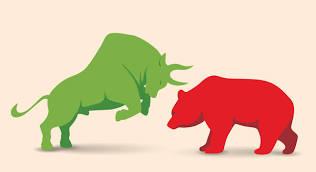Wall Street's biggest bear flips, raises S&P 500 price target by 20%
The headline caught my attention. The link to the Yahoo.com article is above. It's worth reading, and goes to great detail to explain around the fact that major fund managers don't have much of a clue what the stock market will do next.
The fellow at Morgan Stanley goes from shouting, "stocks falling off a cliff," to quietly predicting a 20% gain by year end.
That's what you call, going from a Bear, to a Bull.
To make any sense of this, you need a basic understanding. Here is a little stock market 101...
Wall Street -
The location of the world's largest stock exchange by total market capitalization.
Stock Exchange - ownership (stock) buying and selling.
Capitalization - value.
Mutual Fund - a product that allows many investors to pool their money and buy stocks, bonds, and other investments. Managed by one or a team of professional money managers.
S&P Price target - An educated guess about where the value of the Standard and Poors stock index is going in a certain time frame.
Bear investor - generally pessimistic, and believes stocks are in decline, or about to decline, and prices will go down.
Bear Market - A prolonged period of falling stock prices. A 20% decline from recent highs. Often associated with a Recession, and high unemployment. Notice the color of the bear in the picture above, is red.
High Unemployment - The economy cannot generate enough jobs for people seeking work.
Recession - A significant and widespread downturn in economic activity. The classic definition is two quarters in a row of decling GDP, Gross Domestic Product. Modern polititians have attempted to broaden and redefine what a recession is, so they would not have to claim responsibility.
GDP - the investopedia definition is...the total monetary or market value of all the finished goods and services within a country's borders for a specific time period.
Inflation - the increase in prices over a given period of time. For the last fifty years inflation has averaged 3.7% per year.
Bull investor - generally optimistic that the value and prices of stocks will increase over time.
Bull Market - prices are rising, and investors are optimistic. A 20% increase from recent levels. Usually over a two month or longer period. Notice the picture of the bull in the picture above, is green.
How many Bear markets have we had?
Since 1928, there have been 25 bear markets, according to Yarden Research. This includes 12 bear markets between 1928 and 1945, amd 15 since 1945. The average length of a bear market is 14 months, with the longest being three years, from 1946 to 1949. The 2020 bear market lasted a month, and the 2022 bear market lasted 10 months. (source - internet search)
How many recessions have we had?
There have been 48 recessions.
Wikipedia has a good article with dates and explanations for these recessions. https://en.wikipedia.org/wiki/List_of_recessions_in_the_United_States#:~:text=There%20have%20been%20as%20many,unemployment%20was%20greater%20before%20the
How many bull markets have we had?
There have been 14 bull markets since 1932. The longest one lasted from 1987 to 2000, and gained 582%. The second longest was from 2009 to 2020 and gained 400%. On average Bull markets last 2.7 years, and gain 114%. (source - internet search)
Why stocks? On the surface, why would anyone invest in such a volatile system. More bears than bulls, and 48 recessions...The reason is, over time, there have have been 48 recoveries from those 48 recessions.
Over time, the stock market, and buying and holding mutual funds is the best calculated gamble we have to retire with some dignity. A mutual fund has hundreds, maybe thousands, of individual stocks. Almost every financial advisor says do not buy single stocks. The Standard and Poors 500 is a index of 500 stocks. The average return for the S&P is 10%. For the last thirty years it's 10.5%.
The elephant in the room...Inflation - If we do nothing, and hope it works out, annual inflation reduces our ability to maintain our lifestyle. Pay increases may not, and usually do not keep up with inflation. The average inflation rate per year for the last fifty years is 3.7%.
photo credit, Ganesh Kumar S. A link to his article about his article at about relationships, and the elephant in the room. https://ganesh-kumars.medium.com/how-to-break-the-barrier-and-talk-about-the-elephant-in-the-room-in-your-relationships-7b6a8568d49
Here is a good article from Investopedia about Inflation...
An interesting Forbes article on Bull Markets.
a key takeaway on the article is...
"for patient, well diversified investors..."
Being patient, and well diversified takes some of the guessing, and luck out of the equation.
Don't be intimidated. Start investing in your retirement future NOW. Your learning begins with your participation. Be conservative to start out with. Educate yourself and learn what is going on. Listen to others. Form your own opinions, and make your own choices.
A link to an earlier blog story that talks about the urgency of starting now, and starting early.
Some of the people shouting the loudest are trying to separate you from your money with fees and cost arrangements that will eat into your gains.
In baseball, when your team is batting, a base hit and a walk accomplish the same thing!
If you didn't understand that, you might force it to the point that you strike out or hit a bad pitch, rather than take the walk. Get enough runners on base, and you are always in the game.
Investing is kind of the same thing. There is more than one way to get to first base!
If the people managing billion dollar funds don't know where the stock market is going, you and I can't worry too much about it either. It's a decades long, patience driven, diversified effort on your part.
This Dave Ramsey article breaks down the basics of his investing philosophy.
Bears or Bulls? Walks or line drives? Get to first base and keep learning!


